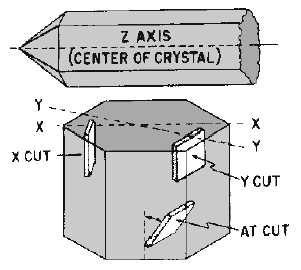2-24
each part shifts the phase of the feedback signal by approximately 45 degrees to give the total required
180-degree phase shift.
Q-15. Which components provide the regenerative feedback signal in the phase-shift oscillator?
Q-16. Why is a high-gain transistor used in the phase-shift oscillator?
Q-17. Which RC network provides better frequency stability, three-section or four-section?
CRYSTAL OSCILLATORS
Crystal oscillators are those in which a specially-cut crystal controls the frequency. CRYSTAL-
CONTROLLED OSCILLATORS are the standard means used for maintaining the frequency of radio
transmitting stations within their assigned frequency limits. A crystal-controlled oscillator is usually used
to produce an output which is highly stable and at a very precise frequency.
As stated earlier, crystals used in electrical circuits are thin sheets cut from the natural crystal and are
ground to the proper thickness for the desired resonant frequency. For any given crystal cut, the thinner
the crystal, the higher the resonant frequency. The "cut" (X, Y, AT, and so forth) of the crystal means the
precise way in which the usable crystal is cut from the natural crystal. Some typical crystal cuts may be
seen in figure 2-19.
Figure 2-19.—Quartz crystal cuts.
Transmitters which require a very high degree of frequency stability, such as a broadcast transmitter,
use temperature-controlled ovens to maintain a constant crystal temperature. These ovens are
thermostatically controlled containers in which the crystals are placed.
The type of cut also determines the activity of the crystal. Some crystals vibrate at more than one
frequency and thus will operate at harmonic frequencies. Crystals which are not of uniform thickness may
have two or more resonant frequencies. Usually one resonant frequency is more pronounced than the
others. The other less pronounced resonant frequencies are referred to as SPURIOUS frequencies.
Sometimes such a crystal oscillates at two frequencies at the same time.
The amount of current that can safely pass through a crystal ranges from 50 to 200 milliamperes.
When the rated current is exceeded, the amplitude of mechanical vibration becomes too great, and the



